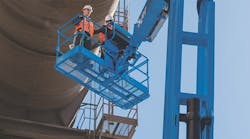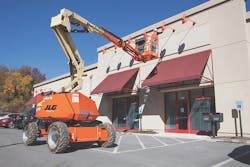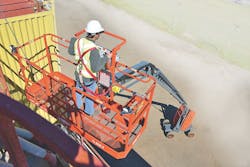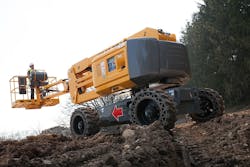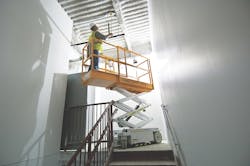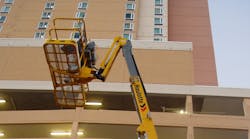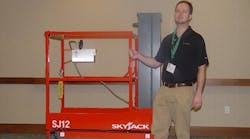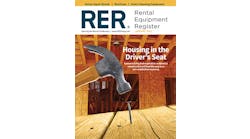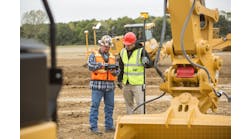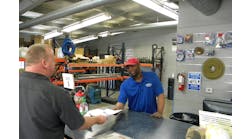It’s a time of growth in the rental industry and nowhere is the general upswing more apparent than in the aerial work platform industry. With aerials being the largest volume category equipment in the rental space, RER asked several leading aerial equipment manufacturers to discuss the trends in their own equipment and to take a look at the market as a whole.
As the maker of the industry’s tallest boomlift – albeit by only a few feet compared to Genie’s – JLG Industries, not surprisingly, sees a trend towards larger and taller machines.
“Bigger self-propelled lifts can be used in many new applications where smaller lifts had never been used in the past,” says Alan Loux, vice president of global marketing for the McConnellsburg, Pa.-based JLG.
According to Loux, JLG is focusing on innovation to deliver the best total cost of ownership. He adds that the company is working on meeting the rental industry’s requirements with machine designs that simplify maintenance for maximum in-service time and is continually improving with technologies, such as ClearSky telematics, that enhance owners’ profitability, with value-added offerings such as training and aftermarket support.
Genie, based in Redmond, Wash., has also gone bigger, having been the first to reach the 180-foot level with its SX-180 boomlift, introduced in 2013. Genie, based in Redmond, Wash., has also gone bigger, having been the first to reach the 180-foot level with its SX-180 boomlift, introduced in 2013, and this year adding the SX-150 to its Super Boom family.
“The aerial market is strong,” says Karen Stash, senior director of global marketing and product management for Terex Aerial Work Platforms, which owns the Genie brand. “The post-recession utilization rates are at record highs. Construction has been strong in the southeast and the west. Telehandlers as a category have reached just over 80 percent time utilization, which is about as high as you can get. Rental rates, depending on the type of equipment, are up 20 to 30 percent compared to 2011.”
Stash notes that telehandlers are a very popular item now with rental customers. “North American rental companies de-fleeted telehandlers heavily in the last downturn and they now need to build fleets back up.” Genie recently launched the GTH-636 and GTH-1256, completing its line.
Skyjack, based in Guelph, Ontario, Canada, is seeing this as a positive time in the industry. “Industry surveys indicate revenue growth at 8 to 10 percent and in some cases higher than 2014,” says president Brad Boehler. “So the upside is very positive. North America remains ahead of the pack. In Europe, issues related to Greek debt continue to make waves. The exception is the U.K., where the market is strong and we have continued to grow. Elsewhere, Australia has come back with a vengeance. Brazil continues to be quiet, but we seem to be more than holding our own in that reduced market.
“In terms of specific machine types, it’s a very general scenario with fleet growth across classes and types. From our point of view, rough terrain scissorlifts seem to have rebounded after some relatively quiet years.”
Skyjack is also reaching higher in its boomlift arsenal, with the new SJ82T and SJ86T, which the company launched at The Rental Show, bringing the Canadian manufacturer into the 80-foot-plus range. “The launch of the SJ86T has been very positive with orders at the show for that unit exceeding our expectations.”
Boehler believes the industry needs to look at technologies that improve cycle times. “To that end, we have introduced the motor controller as an option on all our DC scissors,” he says, adding that the traditional Skyjack units will still be available. The motor controller is an enhancement to ensure that only the power required for the requested task is generated.
“This option also offers additional benefits such as longer battery life, lower energy consumption, improved environmental credentials, optimized maneuverability and quieter operations,” he adds.
Leroy “Buddy” Dieter, vice president of AWP operations for French manufacturer Haulotte, says jobsite and worker safety continues to be a priority and Haulotte just recently introduced its secondary guarding device, the Haulotte Activ’Shield Bar.
“With all of the implications that Tier IV brings, cost-effective alternatives with performance-driven capabilities for indoor/outdoor applications seems to be a noteworthy direction,” says Dieter. “Hybrid technology may be an option worth exploring further. We are seeing more units with varying power options, ranging from diesel, gas/LP, bi-energy, with AC electric and DC electric drive. We are also seeing the working envelope capabilities being stretched up, out and down, with low-level access models that can operate in an office environment because of floor-loading sensitivity. Also, electric slab scissors are being designed to reach the 45-foot working height, fully operable at full extension, with chassis dimension that allows access through narrow aisle ways and fit through an industrial double door.”
Custom Equipment specializes in low-level access electric scissorlifts and hybrid units. “We’ve noticed a rise in lift use for building renovations, new commercial projects, hospital construction and high-rise apartments,” says Justin Kissinger, marketing manager. “Our low-level access lifts allow contractors to achieve working heights up to 20 feet. The lifts also have low floor-loading pressures to prevent damaging sensitive flooring, including tiled floors and mezzanines. They also have easy platform access through full-swing gates and are ergonomically designed to minimize user fatigue. Many of the Hy-Brid Lifts feature a zero-turn radius for easy maneuverability in narrow hallways and around corners.”
Kissinger says customers are increasingly concerned about safety, adding that full-swing gates and a low step-in height on each lift make loading materials safe and easy because operators don’t have to duck under bars and chains.
Don Ahern, CEO of Ahern Rentals, operating manager/president of Xtreme and owner of Las Vegas-based Snorkel, injects a note of caution into the discussion while acknowledging that an upturn in the aerial market has been going on for three and a half years. “That’s a long time and things can change on a dime,” he says. “A lot of equipment has been migrating into the oil-and-gas sector. What’s going to happen to all the equipment if the oil-and-gas sector goes soft? If there is a whole flood of equipment that moves back into the commercial side, that would reduce used equipment prices and utilization levels, which could be a real problem. We’ve got to be cautious.”
Nonetheless, Ahern says, there are, currently, high activity levels in the aerial market. “There are lots and lots of major projects going on, including as many as 300 projects exceeding $1 billion in value underway in the U.S. right now,” he notes.
Ahern says that customers are looking for products that are user/operator friendly, durable and sturdy, allowing for easy accessibility for potential repairs.
What’s going on?
With construction rental on an upswing, aerial manufacturers are aggressively introducing multiple products, filling out their lines and pushing boundaries into new areas.
JLG
At this year’s Rental Show, JLG introduced three new boomlifts, its largest scissor lift, an upgraded line of SkyTrak telehandlers and a redesigned line of JLG brand telehandlers.
The JLG telehandlers have been redesigned and reengineered from the ground up. The launch includes five machines, ranging in capacity from 6,600 to 12,000 pounds, and in height from 42 to 55 feet. Changes include a redesigned cab for improved operator comfort and control, a rear-axle stabilization system, and improved serviceability. Options include a reverse-sensing system, an integrated digital display with back-up camera and digital load charts, and a ride-control system to enhance operator confidence.
New telehandler accessories include a pipe grapple, a material handling arm and a trash hopper.
JLG launched completely redesigned 400S and 460SJ telescopic straight boomlifts and the 450AJ articulating boomlift. Enhanced system designs and more durable hoods increase in-service time.
The 5394RT high-capacity, rough-terrain scissorlift allows operators to place more personnel, tools and materials in the platform. The unit features steel hoods for toughness and auto-leveling outriggers for rapid setup.
The updated SkyTrak telehandlers feature single joystick control, a redesigned dash panel display. Outside boom functions are faster, and the rear counterweight now includes an integrated retrieval device.
JLG introduced two new LiftPod personal portable lifts, the FT140 and FT70. The units provide working reach to 20 and 13 feet, respectively.
On the hybrid front, a year ago JLG introduced a four-wheel electric drive hybrid boom, the H340AJ, which combines diesel fuel and an electric power system. The unit provides fuel savings in the 30-percent range, the company says, is quieter and produces fewer carbon emissions.
Genie
Genie has a well-rounded and complete line. Beginning with material lifts, designed for one person to set up, operate and transport, Genie material lifts range from 200 to 1,000 pounds to heights up to 26 feet.
Genie elevating work platforms range from heights of 11 feet, 5 inches to 40 feet, 4 inches, yet can still be rolled through a standard single or double doorway when stowed. Except for the Genie Runabout, the units are manually propelled.
Genie scissorlifts range from load capacity of 500 to 2,000 pounds to platform heights of up to 53 feet. The line includes an electric unit for indoor use and rough-terrain models.
In the articulating boom category, which Genie revolutionized with the introduction of the Z-30/20 in 1985, Z-booms are used to access relatively confined work areas and provide versatility with up-and-over positions. The platform heights of Genie models range from 30 to 135 feet, platform capacities of up to 600 pounds, and horizontal outreach of up to 70 feet. Genie also has trailer-mounted Z-booms with platform heights up to 50 feet.
In the telescopic “stick” boom area, Genie S booms can lift 500 to 1,250 pounds with platform heights of 40 to 180 feet with outreach of up to 80 feet.
Genie telehandlers have a maximum load capacity of 5,500 to 15,000 pounds, a working height of up to 56 feet and horizontal reach of up to 42 feet.
Skyjack
Skyjack’s vertical mast lifts are zero emission, compact units with low floor loading, which means they can be used in more applications such as finished and ornamental floors. The company makes 12-foot and 16-foot machines. Front-wheel hydraulic drive with 90-degree steering gives a zero inside turning radius.
Skyjack offers a range of six DC scissorlifts with platform heights up to 32 feet and a range of six rough terrain scissorlifts with platform heights up to 50 feet.
DC electric scissors include 15-foot and 19-foot compact models and conventional models from 20 to 32 feet in height.
Mid- and full-size rough-terrain scissorlifts are equipped with Skyjack’s axle-based four-wheel-drive system with a “Detroit locker” type rear differential and limited slip front differential. Models range from working heights of 26 feet to 41 feet. Full-size models range from 31 to 40 feet in height and 88- to 92 inches in width.
Telescopic boomlifts range from 40 feet 7 inches to the new well-received 86-foot unit. The machines feature axle-based drive systems, designed for applications that demand outreach in construction and industrial applications with limited access. Indoor and outdoor applications are supported by dual fuel engine options. Tail swing is minimized for maneuvering in confined spaces. Jib boom models provide extra working range.
Articulating boomlifts include the SJ46 AJ 46-foot, 3-inch working height unit and the SJ63 AJ with a working height of 63 feet, 7 inches.
Skyjack telehandlers range from 6,000- to 20,000-pound capacities with maximum reach ranging from 42 to 56 feet.
Haulotte
Haulotte, the French manufacturer with U.S. headquarters in Archbold, Ohio, has electric articulating boomlifts from 19 to 39 feet of platform height, featuring the HA32CJ with a working height of 37 feet 10 inches and an up-and-over clearance of 15 feet, 7 inches. Rough-terrain articulating boomlifts range from 46 feet to 130 feet of platform height, including 51-, 61-, 80- and 100-foot units. New is the HA46 RTJ Pro with 51 feet 11 inches of working height and 26 feet 1 inch of up-and-over clearance.
Telescopic boomlifts range from 40-foot platform height to 135 feet and include 44-, 61-, and 67-foot heights. Haulotte has a full range of electric rough terrain scissorlifts, ranging in height from 19 feet to 39 feet. Diesel-powered rough terrain compact scissorlifts range from 26 feet platform height with the 2668RT to the 53-foot 5388RT, with units at the 33- and 43-foot level.
Electric articulating booms range from 32 to 43 feet. Haulotte has vertical lifts from 13 to 26 feet in height, and telehandlers ranging from 7,700 pounds and 32 feet to 9,000 pounds and 55 feet. Haulotte also has light aerial lines of towables and self-propelled x-booms from 35 to 55 feet in height.
Snorkel
The company’s new line of electric slab scissorlifts was introduced to North America at the Rental Show in New Orleans. The units have been designed with a focus on the rental industry.
“We are doing a lot of work on hand control CANbus systems,” says Ahern. “This commonality includes using Hawe valves. We use them with a lot of our hydraulics and we are trying to make that standard across the booms.”
The new scissorlifts include four models, ranging from the S3219E, with a 19-foot maximum platform height from a 32-inch wide chassis to the S4732E, a 32-maximum platform height from a 47-inch wide chassis. Snorkel also has a new line of mid-size telescopic boomlifts. The 660SJ is a 66-foot rough-terrain unit with a 6-foot 6-inch jib. Built to handle tough environments, the 660SJ has an all-steel cowling and boom, fully proportional controls for all boom functions and a tri-entry platform with saloon-style entry gates and the Snorkel Guard secondary guarding system.
Snorkel recently introduced its first-ever telehandlers, with the SR5919 the first model of new rough-terrain units.
Snorkel is still producing its S3970RT compact rough-terrain scissorlift; MB26J self-propelled mast boomlift; A46JRT rough terrain articulated boomlift with a Tier 4 engine, and the TM12 telescopic mast lift with roll-out extension deck, and more.
Custom Equipment
Custom’s hybrids include push-around models and electrically driven units. Each push-around model – the HB-P527, HB-P827 and HB-P1027 has zero-turn radius and 27-inch wide platforms, facilitating maneuverability. Electrically driven models include the HB-830, HB-1030, HB-1230 and HB-1430 models with working heights up to 20 feet, featuring slide-out deck extensions that accommodate up to 250 pounds. Platforms can accommodate up to 750 pounds, designed for electrical or drywalling jobs or industrial maintenance where multiple tools and materials are required.
What comes next?
Boehler believes the advent of new ANSI standards will lead to technologies that are new to North America such as load sensing.
“Skyjack continues to look to develop its boom products, with the next in line being articulated booms, both diesel and electric,” he says. “Scissor-wise we are well on the way with some DC electrics with higher platform heights.”
More environmentally friendly AWPs are attracting the interest of rental companies as demand grows and for cost-saving reasons.
“Hybrid lifts have only two hydraulic connection points, one at the hydraulic pump and the other at the cylinder,” says Custom Equipment’s Kissinger. “This significantly reduces maintenance and the chance of a leak occurring. Electric-based systems draw fewer amps and less power than hydraulic powered systems, contributing to a long operating life.”
Genie’s Stash also says that hybrids will gain traction in the aerial market. “They use less fuel and are quieter, which makes them ideal for certain types of indoor environments,” she says. She adds that continuing focus on the total cost of ownership will be increasingly important in the rental industry.
“Customers tend to focus on the initial acquisition cost but that’s not the entire equation,” Stash says. “It’s definitely a big piece of it – you have to be competitive – but it’s what happens between acquisition and disposal. What about warranty? How about servicing the equipment? And maintenance time?”
Haulotte’s Dieter agrees that hybrids will become increasingly attractive in the aerial market and notes that Haulotte is exploring several concepts. He also expects that diagnostic and energy efficiencies will be increasingly important in the aerial market and that telematics will expand.
In the future, Skyjack’s Boehler says “the advent of new ANSI standards will see technologies that are new to North America. Load sensing and the like will be seen in the region for the first time.”
Skyjack will continue to develop its boom products, Boehler says, with next in line being articulated booms, both diesel and electric. “Scissors-wise we are well on the way with some DC electrics with higher platform heights,” he says. “On the telehandler front, we have Tier 4 final developments on the VR range plus a few other surprises.”
Snorkel plans to bring out more telehandlers, up to 15,000 pounds. Telehanders in larger weight classes will be Xtremes.
“[Snorkel telehandlers] will be built and priced competitively for 12,000 pounds and down,” says Ahern. “They will be rental friendly and rental priced.”
Ahern adds that between Snorkel and Xtreme, the company will produce some 7,000 machines this year.
Most aerial manufacturers agree the industry will to continue to produce bigger machines with more emphasis on telematics, alternative fuels and advanced capabilities such as load sensing as the aerial industry continues to evolve.
